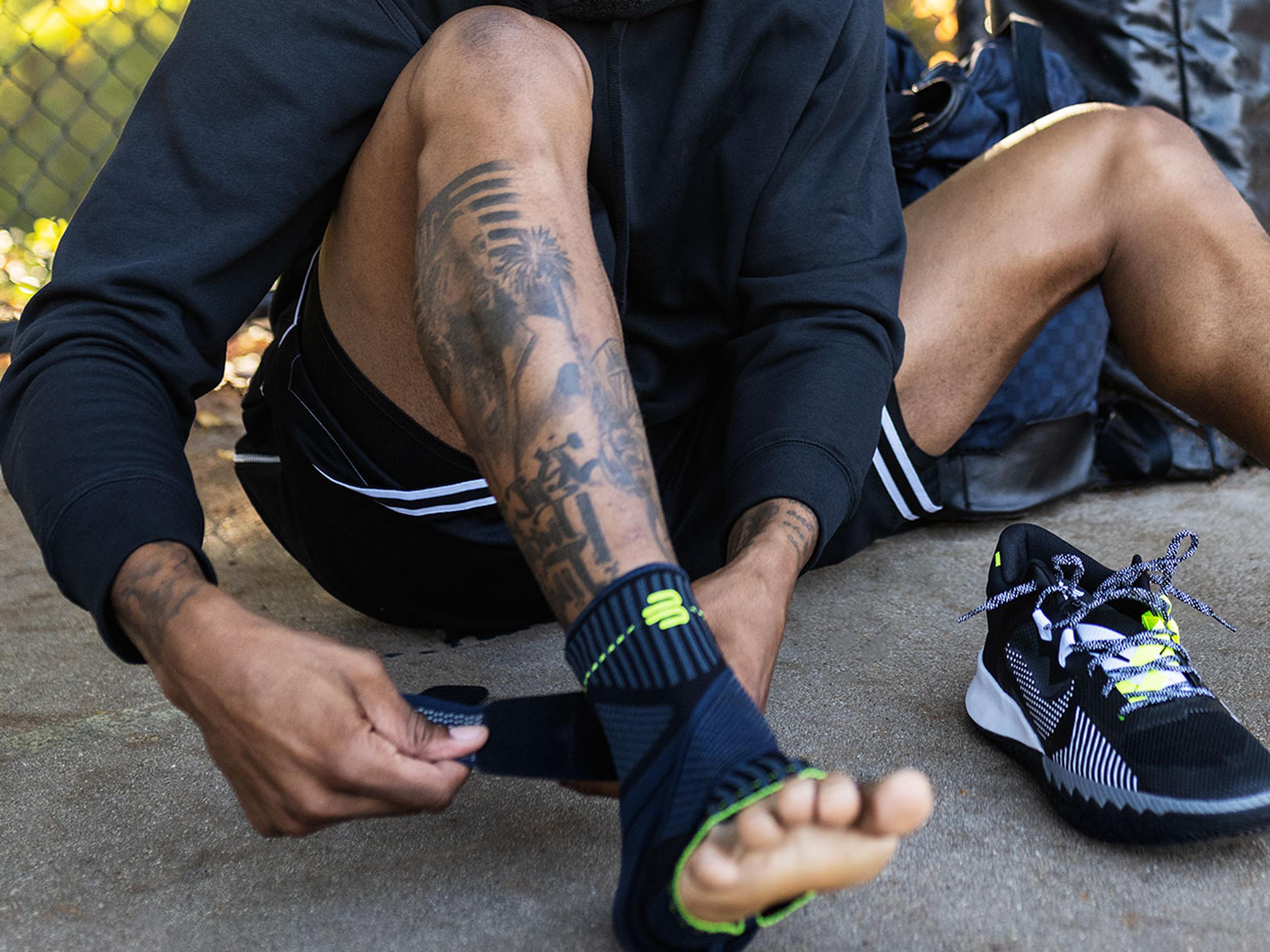Ankle sprains: The types, causes, and best treatments
Ankle sprains are the most common injuries seen in sports. While they generally respond well to conservative treatments, ankle sprains can lead to long-term problems if you do not manage them appropriately.
Also, research shows that once you’ve had an ankle sprain, you’re 3.5 times more likely to suffer another ankle sprain than someone who hasn’t had one.
So, the two most important things you can do when you sprain your ankle are:
- Get an accurate diagnosis, and
- Start with the correct treatment as soon as possible.
A sports doctor or physical therapist can assess and diagnose your injury and will be able to tell you what treatment you need.
Quick overview of ankle anatomy
To understand the different types of ankle sprains, you first need to know the parts of the ankle generally involved in an ankle sprain.
The ankle bones
The ankle joint is formed by three bones, including:
- The tibia – the large bone in the center of your lower leg (shinbone)
- The fibula – the long, thin bone on the outer side of your lower leg
- The talus – the small ankle bone that rests on top of your heel bone (calcaneus) but under your tibia
The ankle ligaments
Ligaments are bands of soft tissue that hold bones together and provide stability to joints. Several ligaments stabilize your ankle on the inner, outer, and upper sides. The ligaments attach the bones to one another.
These ankle ligaments are sprained when they’re overstretched or torn. The type of ankle sprain injury you have depends on which ligament(s) are affected.
The ankle cartilage
The ankle joint is lined with cartilage – a smooth, rubbery tissue that helps the bones move smoothly against each other. It also acts as a shock absorber to help protect your ankle joint from impact.
Muscles and tendons
The tendons that attach the muscles of the lower leg to the foot all cross the ankle joint. They help to support the ligaments and provide stability to your ankle joint. There are several tendons that run over the front, back and sides of the ankle joint. They help to stabilize it.
Main types of ankle sprains
Lateral ankle sprain
What is a lateral ankle sprain?
A lateral (outer) ankle sprain is the most common type of ankle injury and accounts for about 85% of all ankle sprains.
It involves an injury to the lateral (outside) ankle ligaments. These ligaments prevent your ankle from turning inward excessively.
What causes a lateral ankle sprain?
Lateral ankle sprains are caused by an extreme inward rolling (inversion) of your ankle.
They are common in sports that involve quick changes in direction, such as basketball, tennis, and soccer. And can also occur when you walk or run on uneven surfaces.
The lateral ankle ligaments include the following:
- Anterior talofibular ligament (ATFL)
- Posterior talofibular ligament (PTFL)
- Calcaneofibular ligament (CFL)
Medial ankle sprain
What is a medial ankle sprain?
A medial (inner) ankle sprain is a less common type of ankle sprain. It involves an injury to the ligaments on the inside of your ankle.
Together these ligaments form an interconnected structure called the deltoid ligament. The deltoid ligament prevents your ankle from turning outwards (eversion) excessively.
Medial ankle sprains are less common than lateral ankle sprains because it takes much more force for the deltoid ligaments to tear. The reasons for this are:
- The ligaments are more robust and thicker than the lateral ligaments.
- The fibula protects ligaments from overstretching by blocking excessive outward ankle movement – meaning they rarely have the chance to overstretch.
However, medial ankle sprains are usually quite severe and often accompanied by other injuries, such as fibular fractures or a high ankle sprain.
What causes it?
A medial ankle sprain is caused when your ankle rolls outward excessively, or a strong force is applied to your ankle that forces it to turn out excessively. For example, when someone lands on your ankle after a jump in rugby or during a tackle in soccer.
The medial ankle (deltoid) ligaments include the following:
- Tibiotalar ligament (TTL)
- Tibiocalcaneal ligament (TCL)
- Tibionavicular ligament (TNL)
Medial ankle sprains are caused by your foot being forced outward, when someone steps on the outside of your ankle. Like in this picture:
High ankle sprain (syndesmotic injury)
What is a high ankle sprain?
A high ankle sprain is a tear or overstretching of the ligaments that connect your two lower leg bones (tibia and fibula) just above your ankle joint. This joint between the two bones is called a syndesmosis.
A high ankle sprain is also called a syndesmotic injury. And the ligaments, the syndesmotic ligaments.
What causes a high ankle sprain?
A high ankle sprain happens when your foot is dorsiflexed (pointed upward) and twisted either inwards or outwards at very high speed and with extreme force.
It is usually caused by a collision or sudden twisting, turning, or cutting motions while running or jumping, or skiing.
Due to the high-impact forces that cause this injury, high ankle sprains rarely happen in isolation. They are often accompanied by other ankle sprains, fractures, or dislocations.
They require significantly more recovery time, treatment monitoring, and specialist input than medial and lateral sprains.
So, for the purposes of this article, we will focus on medial and lateral ankle sprains only.
The high ankle (syndesmotic) ligaments include the following:
- Anterior and posterior-inferior tibiofibular ligaments (AIFTFL and PIFTFL)
- Transverse tibiofibular ligament (TTFL)
- Transverse tibiofibular ligament
- Interosseous ligament
Sprains can injure more than just the ligaments
When you sprain your ankle, the ligaments are not the only injured structures. Often, you tear or pull the muscles or tendons that cross over your ankle. And sometimes you can bruise or chip the cartilage or bone too.
This will impact the grade of your injury and your healing time.
Ankle sprain symptoms and grades of injury
Symptoms of ankle sprain
The most common symptoms of an ankle sprain are:
- Pain, especially when you put weight on your ankle or move it in a certain way
- Swelling
- Bruising or skin discoloration
- Tenderness to touch
- Ankle stiffness or restricted movement
- Ankle instability (a feeling that your ankle may give way)
You will usually start to notice these immediately after your injury occurs. But, it may take a few hours or even a day or two for them to develop fully. They will also vary depending on the grade of your ankle sprain.
Ankle sprain grades
Typically, ankle sprains refer to ligament injuries and are graded from least to most severe. For example:
Ankle sprain grades
Treatments and recovery times are often based on these grades, but these aren’t always accurate reflections of your ankle injury.
The problem with this grading system
This traditional grading system accounts for your ligament injury. But, it doesn’t consider any other ankle injuries that may have coincided with it.
For instance, you could have torn your deltoid ligament (Grade III), but you may have also fractured your fibula. Or, you could have had a partial lateral ligament tear (Grade II) and injured some of your ankle cartilage.
In these situations, each injury should be considered separately. And, your treatment plan and healing time will differ from someone who only has an isolated Grade II or III ankle ligament sprain.
A better way to grade an injury
A grading system should be inclusive. It should classify ankle sprain injuries as minor, moderate, or severe by considering all the structures you’ve injured. And not only the ligaments. For example:
- A minor sprain: No cartilage or bone damage, and only a Grade I ligament tear. You may also have pulled a muscle.
- A moderate sprain: Some cartilage or bone bruising, and a Grade II ligament tear. You may have torn a muscle but your tendons are intact.
- A severe sprain: A mix of cartilage damage, significant bone bruising, and sometimes even a fracture, with a Grade 2 or 3 ligament tear. You may also have torn a tendon.
As you can see, this grading system gives you a better idea about the full extent of your injury, and it helps you plan your treatment better. It also enables you to set realistic goals based on accurate expected recovery times.
Ankle sprain recovery times
Depending on the type and severity of your sprain, your recovery time may be very individual. Here are some averages for orientation. Some people will recover more quickly than others.
Ankle sprain recovery times
- Minor sprains: 2 to 6 weeks
- Severe sprains: 6 months or longer
- Moderate sprains: 8 to 16 weeks
Injuries that can prolong your recovery include:
- Tendon injuries
- Cartilage injuries
- Bone fractures
- Bone bruising (this can often cause lingering pain and stiffness for extended periods)
If you injured any of these structures you will need to consider them in your treatment plan.
Ankle sprain treatments
The best ankle sprain treatment will always depend on your injury. But there are a few general things that have been found to help speed up your recovery, regardless of your injury. These include:
Relative rest
This means avoiding any activities that worsen your ankle sprain symptoms but getting started with early protected ankle movement. This can help reduce ankle swelling and stiffness, help promote healing, and prevent re-injury.
PRICE (Protect, Rest, Ice, Compression, and Elevation)
PRICE is a standard treatment protocol used for ankle sprains and other acute injuries.
Although there is conflicting evidence about its use, the main aim of the PRICE protocol is to reduce pain and swelling in the first few days after your ankle sprain.
Ankle braces or taping are often used for ankle sprains. They help support your ankle joint and can take some of the pressure off the injured ligaments while you heal.
Braces and tape are usually preferred over ankle casts because they allow protected movement.
Although there’s still debate over the best type, semi-rigid ankle braces are generally thought to be the most effective support for ankle sprains.
If you’re struggling to decide what type of brace to use, we’ve discussed the benefits of the different types of ankle braces and how to use them alongside your ankle sprain rehab here.
Ankle sprain exercises
Evidence suggests that you should start with exercises after an ankle sprain as soon as possible. But, these should be matched to your type of injury and the stage of healing you’re in. This can speed up your recovery, improve function, and help prevent re-injury.
The best rehabilitation program for ankle sprain
The best ankle sprain rehab program includes a wide range of exercises and is progressive. Meaning it becomes more challenging as your ankle recovers.
The main types of exercises to include in your program are:
The best rehabilitation program for a sprained ankle
Goals and milestones
The goal of rehabilitation is to return to all your regular activities without pain or the risk of re-injury. But, it’s important not to rush the process.
It’s best to have set milestones or targets to work towards before progressing to the different levels of your exercise program.
Progressing too quickly will only cause you to miss vital steps in your recovery, leading to setbacks or re-injury.
The Exakt Health app‘s ankle sprain program provides you with all the exercises and advice you need to recover from an ankle sprain. It suggests what milestones you should reach before progressing your exercises and also includes a program that helps prevent re-injury.
Manual mobilization
When you’re not reaching your expected targets with ankle sprain exercises, joint mobilizations may be able to help boost your progress.
These are small movements applied (usually by a physical therapist) to your ankle joints that mimic their natural motion. They can help your ankle joints move better and free up more of your ankle range of motion.
Studies show that ankle joint mobilizations can relieve pain, reduce stiffness, and improve function after an ankle sprain. But, these effects are usually short-lived.
If you want to get the most out of their effects, research suggests you should combine joint mobilizations with exercises.
The best treatment for ankle sprains
Of all the treatments mentioned above, evidence suggests that starting progressive ankle sprain exercises early and using a brace is the most effective way to treat ankle sprains.
What to avoid when recovering from an ankle sprain?
Anti-inflammatory medications
NSAIDs (non-steroidal anti-inflammatory drugs) are often used for ankle sprains because they can help decrease pain and swelling.
Avoid anti-inflammatory medications
If you would like to learn more about how NSAIDs affect healing, we’ve discussed it in detail here.
Conclusion
Hopefully this article has helped you understand more about your ankle sprain, and the best way to treat and prevent it.
All that’s left for you to do is start.
If you’re unsure of where to start with your ankle sprain exercises, or how to progress them, our app is designed by specialist physical therapists to guide and support you through your entire rehabilitation process. With it, injury rehab is easier to stick to and more convenient than ever before.
Wishing you all the best for your recovery!


